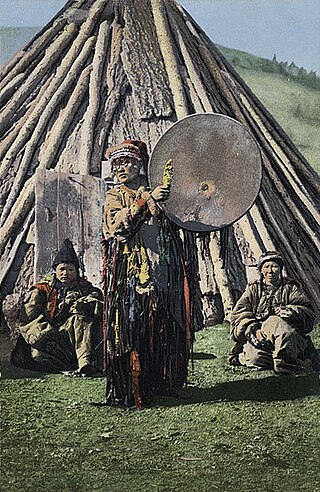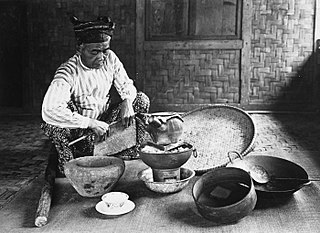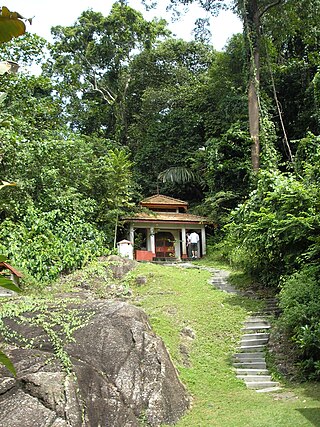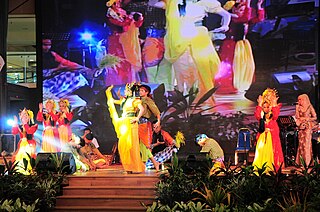
Shamanism is a spiritual practice that involves a practitioner (shaman) interacting with the spirit world through altered states of consciousness, such as trance. The goal of this is usually to direct spirits or spiritual energies into the physical world for the purpose of healing, divination, or to aid human beings in some other way.

A bomoh is a Malay shaman and traditional medicine practitioner. The term is used mainly in Malaysia and parts of Sumatra, whereas most Indonesians use the word dukun. It is often mistranslated into English as medicine man or witch doctor. In colloquial usage, the term bomoh is often interchangeable with another type of shaman or dukun, the pawang, but they generally serve different functions. The bomoh is primarily a healer, herbalist, geomancer, and sorcerer. The pawang on the other hand usually specialises in rituals involving weather, nature, animals, and a good harvest. Their roles do overlap, however, and both claim to act as intermediaries for the spirits and gods.

In Malaysian, Bruneian and Indonesian folklore, Bunian people or Orang bunian are supernatural beings said to be invisible to most humans, except those with "spiritual sight". While the term is often translated as "elves", it literally translates to "hidden people" or "whistling people". Orang bunian are described as beautiful, dressed in ancient Southeast Asian style, and nearly identical to humans in appearance. Some mythological accounts describe the lack of a philtrum. Modern depictions of Orang bunian deviate from the traditional folklore by including elf-like features, pointed ears, high fantasy-influenced attire, or modern Minangkabau long coat clothing.

Filipino shamans, commonly known as babaylan, were shamans of the various ethnic groups of the pre-colonial Philippine islands. These shamans specialized in communicating, appeasing, or harnessing the spirits of the dead and the spirits of nature. They were almost always women or feminized men. They were believed to have spirit guides, by which they could contact and interact with the spirits and deities and the spirit world. Their primary role were as mediums during pag-anito séance rituals. There were also various subtypes of babaylan specializing in the arts of healing and herbalism, divination, and sorcery.

There are many Malay ghost myths, remnants of old animist beliefs that have been shaped by Hindu-Buddhist cosmology and later Muslim influences, in the modern states of Brunei, Indonesia, Malaysia, and Singapore and among the Malay diaspora in neighbouring Southeast Asian countries. The general word for ghost is hantu, of which there exist a wide variety. Some ghost concepts such as the female vampires pontianak and penanggal are shared throughout the region. While traditional belief does not consider all ghosts as necessarily evil, Malaysian popular culture tends to categorise them all as types of evil djinn.

Na Tuk Gong are local guardian spirits worshipped by overseas Chinese communities in Malaysia, Singapore and parts of Indonesia, especially Sumatra. An alternate more generic name for the cult is Datuk Gong, uniting Dato or Datuk from the local Malay word for 'grandfather', which is also used as an honorific title, and Kong or Gong from Chinese, also an honorific title. According to Taoist tradition, a Na Tuk Kong's could hold the official title 拿督尊王. Datuk Keramat, Datuk Gong and Na Tuk Kong all refer to the same deity. For the sake of clarity, the term Datuk, which is universally used to describe the spirit in Malaysia, will be used.
Pelesit is a type of familiar spirit in Malay folklore. It is generally a cricket, or occasionally a grasshopper. The term literally means "buzzer" from the root word lesit meaning to buzz or whizz, as an insect does. They are also called Palasik.
The polong is a type of familiar spirit in Malay folklore. It has the appearance of a miniature woman, the size of the first joint of the finger.
Hantu Air, Puaka Air or Mambang Air is the Malay translation for Spirit of the Water or Water Ghost, which according to animist traditions in Maritime Southeast Asia, is the unseen inhabitant of watery places such as rivers, lakes, seas, swamps and even ditches. Communication between humans and Hantu Air occur in situations based on the well-being of an environment and can be positive or negative. Water spirits are called on and communicated with through ceremonies, rituals, incantations, and in extreme cases exorcisms. Hantu Air is associated with bad things happening to people including missing persons, drowning, flooding and many other incidents.

Dukun is an Indonesian term for shaman. Their societal role is that of a traditional healer, spirit medium, custom and tradition experts and on occasion sorcerers and masters of black magic. In common usage the dukun is often confused with another type of shaman, the pawang. It is often mistranslated into English as "witch doctor" or "medicine man". Many self-styled dukun in Indonesia are simply scammers and criminals, preying on people who were raised to believe in the supernatural.

Malaysian folk religion refers to the animistic and polytheistic beliefs and practices that are still held by many in the Islamic-majority country of Malaysia. Folk religion in Malaysia is practised either openly or covertly depending on the type of rituals performed.

The religious belief of the Datuk Keramat worship can be found in Malaysia, Singapore and along the Strait of Malacca. It is a fusion of Malaysian folk religion, Sufism, and Chinese folk religion in Southeast Asia.

The Temuan people are a Proto-Malay ethnic group indigenous to western parts of Peninsular Malaysia. They can be found in the states of Selangor, Pahang, Johor, Negeri Sembilan and Malacca. The Temuans are classified as part of Orang Asli group according to the Malaysian government. They are also one of the largest and the most widespread of the Orang Asli ethnic groups.
The Tajul muluk is a commonly used name for a system of geomancy, comprising metaphysical and geomantic principles considered when siting or designing buildings to improve and maintain well-being in Maritime Southeast Asia. It was traditionally practiced by shamans and architects from Indonesia and Malaysia. The term actually alludes to a book entitled Tajul muluk which covered a number of other topics including herbal medicine, astrology and dream interpretation along with geomancy. While all these subjects may be categorised under the term ilmu tajul, it usually refers to the otherwise unnamed set of rites and rules for constructing buildings in Acehnese and Malay culture.

Ulek mayang is a classical Malay dance from the state of Terengganu in Malaysia. It is a ritualistic dance performed to appease or invoke the spirits of the sea and is always accompanied by a unique song also called Ulek Mayang. An orchestra comprising drums, gong, violin and accordion accompanies the dance.
Vegetalismo is a term used to refer to a practice of mestizo shamanism in the Peruvian Amazon in which the shamans—known as vegetalistas—are said to gain their knowledge and power to cure from the vegetales, or plants of the region. Many believe to receive their knowledge from ingesting the hallucinogenic, emetic brew ayahuasca.

Malay folklore refers to a series of knowledges, traditions and taboos that have been passed down through many generations in oral, written and symbolic forms among the indigenous populations of Maritime Southeast Asia (Nusantara). They include among others, themes and subject matter related to the indigenous knowledge of the ethnic Malays and related ethnic groups within the region.
Hantu Tinggi is a being similar to 'Hantu Raya' or 'genderuwo' but so tall its body from the waist up is hidden by clouds. It only exists in the Western and Eastern regions of Malaysia. In Thailand, Hantu Tinggi likely resembles a closer myth called Preta.
Shamanism is a religious practice present in various cultures and religions around the world. Shamanism takes on many different forms, which vary greatly by region and culture and are shaped by the distinct histories of its practitioners.
Saba dance is a traditional Malay dance originated in the state of Terengganu, Malaysia. It is a ritualistic dance that was used for healing purposes.











